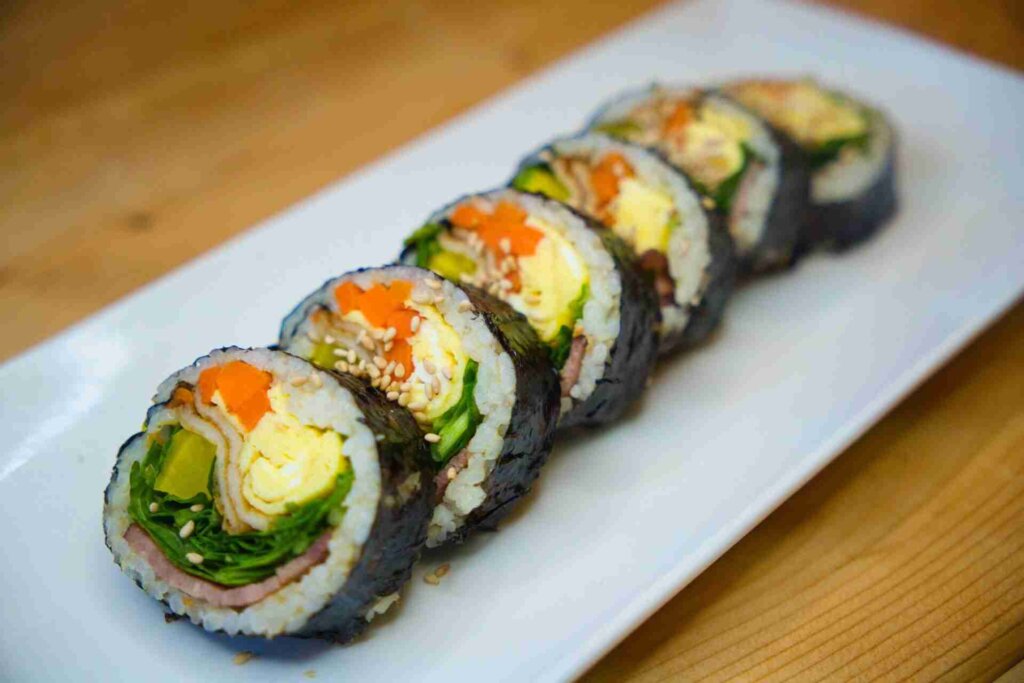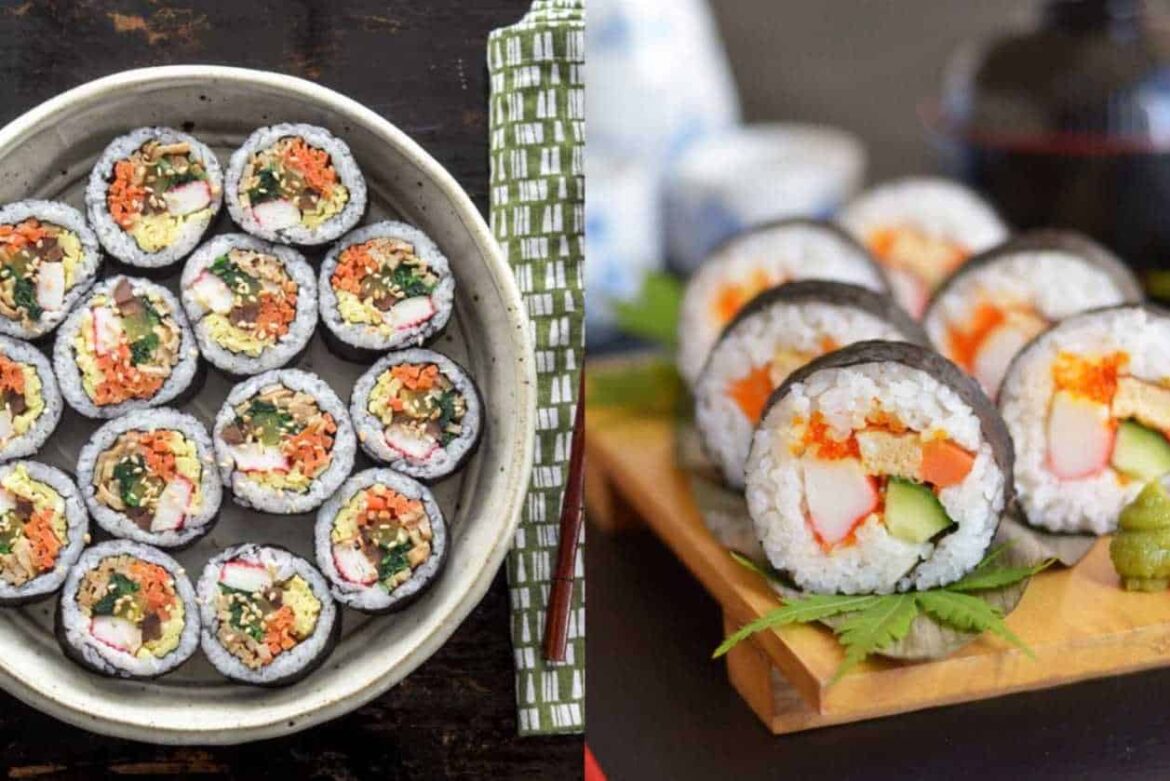Kimbap and sushi are two popular rolled dishes that have become a staple in many cultures around the world. Kimbap is a traditional Korean dish made with rolled rice, vegetables, and meat or fish, while sushi is a traditional Japanese dish made with vinegared rice and various fillings such as fish, seafood, and vegetables. Both are rolled dishes but have different ingredients, preparation methods, and cultural origins. When deciding between sushi vs kimbap, it’s important to consider the differences in ingredients and preparation methods of the two dishes.
In this article, we will be exploring the definition, origin, and traditional preparation methods of both kimbap and sushi, as well as the differences and similarities between the two.
Introduction
Kimbap and sushi are both popular rolled dishes that have become a staple in many cultures around the world. Both dishes are similar in that they use rice as a base ingredient and can be filled with a variety of ingredients, but they have their differences as well. The purpose of this article is to compare and contrast kimbap and sushi, delving into their definitions, origins, traditional preparation methods, and differences and similarities between the two dishes.
Brief overview of the topic: kimbap and sushi
Kimbap, also known as gimbap or kim bap, is a traditional Korean dish made by rolling cooked rice, vegetables, and meat or fish in seaweed. Sushi, on the other hand, is a Japanese dish made by combining vinegared rice with various ingredients such as fish, seafood, vegetables, and sometimes meat. Both dishes have been enjoyed for centuries and continue to be popular in their respective cultures as well as around the world.
Purpose of the article: to compare and contrast the two dishes
In this article, we will take a closer look at kimbap and sushi, comparing and contrasting the two dishes, and providing a better understanding of what sets them apart and what they have in common. Whether you are a sushi enthusiast or a kimbap lover, this article will give you a deeper understanding of these two delicious dishes.
What is Kimbap?

Kimbap, also known as gimbap or kim bap, is a traditional Korean dish that is made by rolling cooked rice, vegetables, and meat or fish in seaweed. The dish is typically seasoned with sesame oil and salt, and can be served as a meal or a snack. Kimbap has its origins in the Joseon Dynasty of Korea and was originally a dish for the common people. The dish is widely popular in Korea, as well as in other countries like Japan, China and America.
Traditional ingredients and preparation methods
The traditional ingredients used in kimbap are cooked short-grain rice, seaweed, sesame oil, and salt. The rice is seasoned with sesame oil and salt, and then mixed with other ingredients such as carrots, spinach, egg, and meat or fish. The ingredients are then placed on a sheet of seaweed and rolled tightly to form a cylindrical shape. The rolls are then cut into bite-size pieces and served.
Variations and popular fillings
There are many variations of kimbap, with different fillings and seasonings depending on the region or personal preference. Some popular variations include tuna kimbap, which is filled with canned tuna and mayonnaise, and cheese kimbap, which is filled with melted cheese. Other popular fillings include beef, chicken, and squid. Some variations also include additional ingredients such as pickled daikon radish or pickled yellow radish.
What is Sushi?

Sushi is a Japanese dish made by combining vinegared rice with various ingredients such as fish, seafood, vegetables, and sometimes meat. The word “sushi” actually refers to the vinegared rice rather than the fillings, which are called “neta”. Sushi has its origins in ancient Japan, where fish was preserved by fermenting it in rice. As time passed, the fermentation process was shortened and the fish was eventually combined with the rice to create the dish we know today as sushi.
Traditional ingredients and preparation methods
The traditional ingredients used in sushi are sushi rice, fish or seafood, and vegetables. The sushi rice is made by mixing short-grain rice with rice vinegar, sugar, and salt. The fish or seafood is typically raw, although it can also be cooked or marinated. The ingredients are then combined and wrapped in seaweed or placed on top of a ball of sushi rice.
Types of sushi and popular fillings
There are many types of sushi, each with their own unique characteristics and ingredients. Some popular types of sushi include nigiri, which is a small ball of sushi rice topped with a piece of fish or seafood; maki, which is sushi rolled in seaweed and filled with fish, seafood, or vegetables; and sashimi, which is thinly sliced raw fish or seafood. Some popular fillings include tuna, salmon, yellowtail, eel, and shrimp. Vegetable fillings such as cucumber, avocado, and pickled ginger are also common.
Differences between Kimbap and Sushi
Culinary differences (ingredients, preparation methods)
While both sushi and kimbap use rice as a base ingredient, the ingredients and preparation methods used to make the two dishes are quite different. Kimbap is made with short-grain rice, seaweed, sesame oil, and salt, and the ingredients are rolled tightly together to form a cylindrical shape. Sushi, on the other hand, is made with sushi rice, which is a mixture of short-grain rice, rice vinegar, sugar, and salt. The ingredients for sushi are typically raw fish or seafood, vegetables, and sometimes meat. They are placed on top of sushi rice or wrapped in seaweed.
Cultural differences (origin, history)
Kimbap is a traditional Korean dish with its origins in the Joseon Dynasty of Korea and was originally a dish for the common people. Sushi, on the other hand, has its origins in ancient Japan, where fish was preserved by fermenting it in rice. Sushi is considered as one of the most traditional Japanese dishes and is considered as a delicacy.
Presentation differences (shape, size)
Kimbap is typically presented in bite-size pieces and has a cylindrical shape. Sushi can be presented in various forms such as Nigiri, Maki and Sashimi, and can be in different shapes and sizes. Nigiri sushi is typically presented as small balls of sushi rice topped with a piece of fish or seafood, and Maki sushi is typically presented as rolls. Sashimi is thinly sliced raw fish or seafood.
Similarities between Kimbap and Sushi
Both are rolled dishes
One of the main similarities between kimbap and sushi is that they are both rolled dishes. Both dishes use seaweed or rice to hold the ingredients together in a compact and easy-to-eat form.
Both use rice as a base ingredient
Another similarity between the two dishes is that they both use rice as a base ingredient. In kimbap, short-grain rice is mixed with sesame oil and salt, and in sushi, short-grain rice is mixed with rice vinegar, sugar, and salt to create sushi rice.
Both can be filled with a variety of ingredients
Both kimbap and sushi can be filled with a wide variety of ingredients, such as vegetables, meat, and fish or seafood. This allows for endless possibilities and makes both dishes versatile and adaptable to personal preferences and dietary restrictions.
In conclusion, while kimbap and sushi have their differences in terms of ingredients, preparation methods, and cultural origins, they also share many similarities, such as being rolled dishes, using rice as a base ingredient, and being able to be filled with a variety of ingredients. This makes both dishes delicious and enjoyable for people all over the world.
Conclusion
Summary of the main differences and similarities between kimbap and sushi
In this article, we have discussed the definition, origin, traditional preparation methods, and differences and similarities between kimbap and sushi. Kimbap is a traditional Korean dish made by rolling cooked rice, vegetables, and meat or fish in seaweed, while sushi is a Japanese dish made by combining vinegared rice with various ingredients such as fish, seafood, vegetables, and sometimes meat. Both dishes are similar in that they use rice as a base ingredient and can be filled with a variety of ingredients, but they have their differences as well.
Recommendations for trying both dishes and where to find them
If you are interested in trying kimbap, it can be found at many Korean restaurants or at Korean markets where it is sold as a take-out option. Sushi, it can be found at Japanese restaurants or at sushi bars. If you are unable to find either of these dishes at a restaurant near you, you can also try making them at home with the help of recipe books or online tutorials.
Overall, both kimbap and sushi are delicious and unique dishes that offer a variety of flavors and textures. Whether you prefer the Korean flavors of kimbap or the Japanese flavors of sushi, both dishes are worth trying and experiencing.
